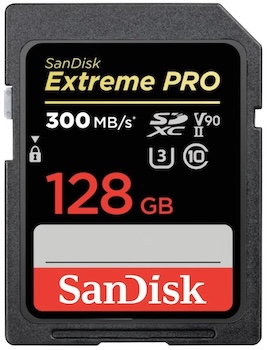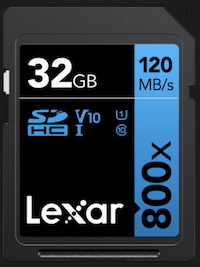Demystifying Memory Cards: Types, Speeds & Camera Compatibility
June 2, 2025 by Marie Joabar
Not long ago, buying a memory card was easy—there were only a few options, and the technology was fairly basic. Today, things have changed. With a wide range of formats, speeds, and capacities, choosing the right memory card for your camera and photography style can be confusing and even overwhelming.
In this article, we'll break down the key differences in card types, capacity, and speed ratings to help you choose your next memory card with confidence .
Let's take a look at the following topics:
1. Memory Card Types & Technology
2. Important Features
3. Memory Card Readers
4. Memory Card & Camera Compatibility
5. Memory Card Brand Recommendation
6. Memory Card Best Practices
1. MEMORY CARD TYPES
- SD (Secure Digital) Cards
SD cards are the most widely used type of memory card in digital cameras. They come in three varieties. The larger the capacity, the more images you can fit on the card.
SD: Up to 2GB of storage (rare today)
SDHC (High Capacity): 4GB to 32GB
SDXC (Extended Capacity): 64GB to 2TB
SD Card Speed Classes to Know:
Speed Class (e.g., Class 10): Minimum sustained write speed (good for still photography).
UHS-I / UHS-II / UHS-III: Ultra High Speed - faster for video, burst shooting and transferring large files quickly to your computer.
UHS-I Up to 104 MB/s
UHS-II Up to 312 MB/s
UHS-III Up to 624 MB/s
V Class (e.g., V30, V60, V90): Optimized for video recording, particularly 4K and 8K
- Note - UHS-II cards are backward-compatible with UHS-I slots, they will work but only at UHS-1 Speeds.

- CFexpress Cards
CFexpress cards are the latest and fastest format, using both PCIe* and NVMe technology.* They’re reliable and offer extremely high write speeds, perfect for 4K/8K video and ultra-fast burst photography.
CFexpress Type A: Used in some Sony Alpha cameras
CFexpress Type B: Used in some Canon, Nikon, and Panasonic high-end models
CFexpress Type C: Not widely adopted yet, but large capacity and speed
*PCIe Peripheral Component Interconnect Express. allows very fast data transfer between the memory card and the camera or computer.
*NVMe Non-Volatile Memory Express. NVMe works on top of PCIe and helps unlock the full potential of PCIe by minimizing delays and speeding up data access.
- XQD Cards
XQD cards were developed for high-performance stills and video recording. They’re faster and durable, using PCIe technology*. Used by some Nikon DSLRs and mirrorless cameras.
- microSD Cards
microSD cards are tiny and mainly used in smartphones, drones, and action cameras like GoPros. However, with an adapter, they can also be used in standard SD slots on cameras.
- CompactFlash (CF) Cards
CompactFlash cards are larger and were once the gold standard for professional DSLRs. Though still used in some high-end DSLRs, CF cards are being phased out in favor of newer formats like CFast and CFexpress.
- CFast Cards
CFast cards look like CompactFlash cards but are a completely different technology. They're designed for professional video and high-speed photography applications. (Not backward compatible with CF cards)
2. IMPORTANT FEATURES
When selecting a memory card, consider these three factors based on your photography requirements.
- Compatibility: Always check your camera’s manual for supported card types and formats.
- Speed: Look at both read and write speeds, especially if you shoot video or high-speed bursts. Write Speed is how fast the camera can receive images from the camera buffer. Read Speed is how fast the images can be downloaded to your computer.
- Capacity: Higher megapixel images and 4K/8K videos need more space, go bigger if needed.

3. MEMORY CARD READERS
Choosing the right memory card reader is just as important as picking the right memory card. A poor-quality or slow reader can bottleneck your workflow, especially when transferring large photo or video files. Choose a reader with a fast connection (USB 3.0 or higher). Choose a good brand; a slow or unreliable reader can corrupt files.
Using the camera to download images is slow, readers provide a faster workflow.
Match the reader with the memory card(s) you use:
- SD / SDHC / SDXC - Almost all readers support this.
- CFexpress Type A/B - Needs specific reader (Type A or Type B). Choose one that matches the type.
- XQD - Needs a dedicated reader, often from Sony or Lexar.
- microSD - Look for a built-in microSD slot or one that supports adapters.
- CompactFlash - Needs a special CF slot.
- Choose a reader with the right USB connection interface (speed matters) This affects how fast files transfer from the card to your computer:
- USB 2.0-~60 MB/s - Basic documents, very slow
- USB 3.0 / 3.1 Gen 1-~5 Gbps (625 MB/s) - Most photography needs
- USB 3.2 / 3.1 Gen 2-~10 Gbps (1250 MB/s) - 4K/8K video and high-volume work
- USB-C / Thunderbolt 3/4-~40 Gbps (5000 MB/s) - Professional workflows
If you’re using high-speed cards like UHS-II, XQD, or CFexpress, get a USB 3.2 or Thunderbolt reader to actually take advantage of the speed.
- Card Reader Brand Recommendations
Lexar – Good multi-card readers
ProGrade Digital – Known for CFexpress, XQD, and SD readers
SanDisk – Great all-around, especially for SD and microSD
Sony – Excellent XQD and CFexpress Type A readers

4. MEMORY CARD & CAMERA COMPATIBILITY
Here's a breakdown of which memory cards are compatible with the Canon, Nikon, and Sony cameras as well as some Fuji and Olympus cameras.
SONY
Most Sonys use SD cards and some can use CFexpress Type A too.
Sony a7 III / a7R III - 2 SD slots (1 UHS-II & 1 UHS-I)
Sony a7R IV - 2 SD slots, (both UHS-II)
Sony a7 IV - 2 slots, (1 CFexpress Type A & 1 SD UHS-II)
The following cameras have 2 Hybrid slots that can accept either SD UHS-II or CFexpress Type A in the same slot, these are true hybrid slots built to handle both types of cards.
Sony a7S III
Sony a7 IV
Sony a7R V
Sony a1
Sony A9 III
Sony FX3 / FX30 / FX6
CANON
Canon Mirrorless cameras
Canon EOS R - 1 SD slot (UHS-II)
Canon EOS RP - 1 SD slot (UHS-I or UHS-II)
Canon EOS R6 / R6 II - 2 SD slots (both UHS-II)
Canon EOS R5 / R5 C - 2 slots (1UHS-II and 1 CFexpress Type B)
Canon EOS R3 - 2 slots (1 SD UHS-II and 1 CFexpress Type B)
Canon DSLR cameras
Rebel series - 1 SD slot (UHS-I)
77D / 80D / 90D - 1 SD slot (UHS-I or II)
6D / 6D Mark II - 1 SD slot (UHS-I)
5D Mark III - 2 slots (1 CF and 1 SD UHS-I)
5D Mark IV - 2 slots (1 CF and 1 SD UHS-I)
7D / 7D Mark II - 2 slots (1 CF and 1 SD UHS-I)
1D X - 2 CF slots
1D X Mark II - 2 slots (1 CFast 2.0 and 1 CF)
1D X Mark III - 2 CFexpress Type B slots
NIKON
Nikon Mirrorless cameras
Nikon Z5 - 2 SD slots (UHS-II)
Nikon Z6II / Z7 II - 2 slots (XQD or CFexpress Type B)
Nikon Z6 / Z7 - 1 XQD slot - can use CFexpress Type B but only with an firmware upgrade
Nikon Z8 - 2 slots (1 CFexpress Type B or XQD, and 1 SD UHS-II)
Nikon Z9 - 2 slots (CFexpress Type B or XQD)
Nikon Z fc / Z30- 1 SD slot (UHS-I or UHS-II depending on model)
Nikon DSLR cameras
D3100 / D3200 / D3300 - 1 SD slot (UHS-I)
D5100 / D5600 - 1 SD slot (UHS-I)
D7000 / D7100 / D7200 - 2 SD slots (UHS-I)
D7500 - 1 SD slot (UHS-I)
D750 - 2 SD slots (UHS-I)
UHS-II cards will also work but won’t provide full speed.
Dual Slots Cameras with XQD/CFexpress Options
D780- 2 SD slots (UHS-II)
D500 - 2 slots (1 SD UHS-II and 1XQD (or CFexpress B w/ firmware update)
D850 - 2 slots (1 SD UHS-II and 1XQD (or CFexpress B w/ firmware update)
D4/D4s - 1 XQD slot
D5 - 2 slots (XQD or CF (depends on version)
D6 - 2 CFexpress Type B slots
FUJI X-T Cameras
X-T1 SD UHS-I only
X-T2, X-T3, X-T4, X-T5 SD UHS-II
OLYMPUS
The OM-D series (and newer OM System models) use SD. Most models support UHS-II, though older ones are limited to UHS-I.
The OM-D E-M10 Series (All Models) UHS-I. UHS-II cards will work but won’t run at full speed.
The following cameras can use UHS-II
OM-1
OM-D E-M1X
OM-D E-M1 Mark II, Mark III
OM-D E-M5 Mark III

5. MEMORY CARD BRAND RECOMMENDATIONS
Delkin Devices - CFexpress Type B (Power series), V90 SD cards
Lexar 2000x
Lexar 633x
Lexar Professional CFexpress B
ProGrade Digital
SanDisk Extreme UHS-I V30
SanDisk Extreme PRO UHS-II V60/V90
Sony TOUGH CFexpress B
6. MEMORY CARD BEST PRACTICES
- Before using a new memory card, format it in your camera.
- After downloading and backing up your images, format the card in your camera before using it again.
- If you have more than one camera, even if they are the same brand, don't share cards between them.
- Avoid touching the gold colored strips on the back of SD cards. This is where the data is stored and the oils from our skin may cause problems.
- if your camera has 2 slots, consider using the second card for backup of the first card, or for overflow.
-Always carry extra cards. If a card fails or gets filled, you'll have a spare.

Choosing the right memory card doesn’t have to be a guessing game. By understanding the different types, features, and compatibility options, you’ll be better equipped to find memory cards that meet your needs and support your photography shooting style.
